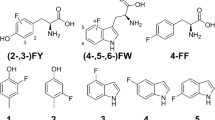Abstract
Aryl hydrocarbon receptor-interacting protein-like 1 (AIPL1) is a specialized chaperone of phosphodiesterase 6, a key effector enzyme in the phototransduction cascade. The FKBP domain of AIPL1 is known to bind the farnesyl moiety of PDE6. Mutations in AIPL1, including many missense mutations in the FKBP domain, have been associated with Leber congenital amaurosis, a severe blinding disease. Here, we report the backbone and sidechain assignments of the N-terminal FKBPΔloop (with a loop deletion) of AIPL1 in complex with a farnesyl ligand. We also compare the predicted secondary structures of FKBPΔloop with those of a highly homologous AIP FKBP. These results show that the FKBP domains of AIP and AIPL1 have similar folds, but display subtle differences in structure and dynamics. Therefore, these assignments provide a framework for further elucidation of the mechanism of farnesyl binding and the function of AIPL1 FKBP.



Similar content being viewed by others
References
Bowes C, Li T, Danciger M, Baxter LC, Applebury ML, Farber DB (1990) Retinal degeneration in the rd mouse is caused by a defect in the beta subunit of rod cGMP-phosphodiesterase. Nature 347:677–680
Clore GM, Gronenborn AM (1994) Multidimensional heteronuclear nuclear magnetic resonance of proteins. Methods Enzymol 239:349–363
Das AK, Cohen PW, Barford D (1998) The structure of the tetratricopeptide repeats of protein phosphatase 5: implications for TPR-mediated protein-protein interactions. EMBO J 17:1192–1199
Delaglio F, Grzesiek S, Vuister GW, Zhu G, Pfeifer J, Bax A (1995) NMR pipe: a multidimensional spectral processing system based on UNIX pipes. J Biomol NMR 6:277–293
Dharmaraj S, Leroy BP, Sohocki MM et al (2004) The phenotype of Leber congenital amaurosis in patients with AIPL1 mutations. Arch Ophthalmol 122:1029–1037
Farber DB, Lolley RN (1974) Cyclic guanosine monophosphate: elevation in degenerating photoreceptor cells of the C3H mouse retina. Science 186:449–451
Gopalakrishna KN, Boyd K, Yadav RP, Artemyev NO (2016) Aryl hydrocarbon receptor-interacting protein-like 1 Is an obligate chaperone of Phosphodiesterase 6 and is assisted by the gamma-subunit of its client. J Biol Chem 291:16282–16291
Johnson BA, Blevins RA (1994) NMR view: a computer program for the visualization and analysis of NMR data. J Biomol NMR 4:603–614
Kolandaivelu S, Huang J, Hurley JB, Ramamurthy V (2009) AIPL1, a protein associated with childhood blindness, interacts with alpha-subunit of rod phosphodiesterase (PDE6) and is essential for its proper assembly. J Biol Chem 284:30853–30861
Linnert M, Haupt K, Lin YJ, Kissing S, Paschke AK, Fischer G, Weiwad M, Lucke C (2012) NMR assignments of the FKBP-type PPIase domain of the human aryl-hydrocarbon receptor-interacting protein (AIP). Biomol NMR Assign 6:209–212
Linnert M, Lin YJ, Manns A, Haupt K, Paschke AK, Fischer G, Weiwad M, Lucke C (2013) The FKBP-type domain of the human aryl hydrocarbon receptor-interacting protein reveals an unusual Hsp90 interaction. Biochemistry 52:2097–2107
Liu X, Bulgakov OV, Wen XH et al (2004) AIPL1, the protein that is defective in Leber congenital amaurosis, is essential for the biosynthesis of retinal rod cGMP phosphodiesterase. Proc Natl Acad Sci USA 101:13903–13908
Majumder A, Gopalakrishna KN, Cheguru P, Gakhar L, Artemyev NO (2013) Interaction of aryl hydrocarbon receptor-interacting protein-like 1 with the farnesyl moiety. J Biol Chem 288:21320–21328
Pittler SJ, Baehr W (1991) Identification of a nonsense mutation in the rod photoreceptor cGMP phosphodiesterase beta-subunit gene of the rd mouse. Proc Natl Acad Sci USA 88:8322–8326
Ramamurthy V, Roberts M, van den Akker F, Niemi G, Reh TA, Hurley JB (2003) AIPL1, a protein implicated in Leber’s congenital amaurosis, interacts with and aids in processing of farnesylated proteins. Proc Natl Acad Sci USA 100:12630–12635
Ramamurthy V, Niemi GA, Reh TA, Hurley JB (2004) Leber congenital amaurosis linked to AIPL1: a mouse model reveals destabilization of cGMP phosphodiesterase. Proc Natl Acad Sci USA 101:13897–13902
Shen Y, Delaglio F, Cornilescu G, Bax A (2009) TALOS+: a hybrid method for predicting protein backbone torsion angles from NMR chemical shifts. J Biomol NMR 44:213–223
Sohocki MM, Bowne SJ, Sullivan LS et al (2000a) Mutations in a new photoreceptor-pineal gene on 17p cause Leber congenital amaurosis. Nat Genet 24:79–83
Sohocki MM, Perrault I, Leroy BP et al (2000b) Prevalence of AIPL1 mutations in inherited retinal degenerative disease. Mol Genet Metab 70:142–150
Stone EM (2007) Leber congenital amaurosis–a model for efficient genetic testing of heterogeneous disorders: LXIV Edward Jackson memorial lecture. Am J Ophthalmol 144:791–811
Trivellin G, Korbonits M (2011) AIP and its interacting partners. J Endocrinol 210:137–155
van der Spuy J, Chapple JP, Clark BJ, Luthert PJ, Sethi CS, Cheetham ME (2002) The Leber congenital amaurosis gene product AIPL1 is localized exclusively in rod photoreceptors of the adult human retina. Hum Mol Genet 11:823–831
Yadav RP, Majumder A, Gakhar L, Artemyev NO (2015) Extended conformation of the proline-rich domain of human aryl hydrocarbon receptor-interacting protein-like 1: implications for retina disease. J Neurochem 135:165–175
Yamazaki T, Lee W, Arrowsmith CH, Muhandiram DR, Kay LE (1994) A suite of triple-resonance NMR experiments for the backbone assignment of 15 N, 13 C, 2H-labeled proteins with high sensitivity. J Am Chem Soc 116:11655–11666
Acknowledgements
This work was supported by the National Institutes of Health Grant EY-10843 to N.O.A.
Author information
Authors and Affiliations
Corresponding authors
Ethics declarations
Conflict of interest
The authors declare that they have no conflicts of interest.
Ethical standards
All of our experiments comply with accepted ethical standards.
Rights and permissions
About this article
Cite this article
Yu, L., Yadav, R.P. & Artemyev, N.O. NMR resonance assignments of the FKBP domain of human aryl hydrocarbon receptor-interacting protein-like 1 (AIPL1) in complex with a farnesyl ligand. Biomol NMR Assign 11, 111–115 (2017). https://doi.org/10.1007/s12104-017-9730-2
Received:
Accepted:
Published:
Issue Date:
DOI: https://doi.org/10.1007/s12104-017-9730-2




